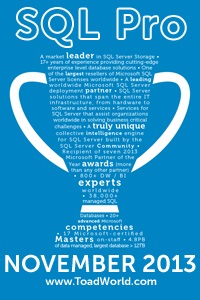Using @@ROWCOUNT can be a bit tricky
3September 16, 2015 by Kenneth Fisher
@@ROWCOUNT is a very useful system variable that returns the number of rows read/affected by the previous statement. It’s frequently used in loops and in error handling.
TL;DR Store @@ROWCOUNT into a variable immediately after the command you are interested in to persist the value for later use.
So why is it tricky to use? Remember that it returns the number of rows affected by the previous statement. Every statement. Look at this piece of code:
BEGIN TRY SELECT TOP 10 * FROM sys.objects END TRY BEGIN CATCH SELECT TOP 5 * FROM sys.objects END CATCH SELECT @@ROWCOUNT
You might think that the result of @@ROWCOUNT would be 10 since that’s the previous command that was run. You might also think it would be 5 since that’s the last command in the code, right? However you would be wrong on both counts. The TRY/CATCH block is actually the last command, so the result of @@ROWCOUNT is 0. If you plan on using @@ROWCOUNT you need to do this:
DECLARE @RowCount int BEGIN TRY SELECT TOP 10 * FROM sys.objects SET @RowCount = @@ROWCOUNT SELECT @@ROWCOUNT END TRY BEGIN CATCH SELECT TOP 5 * FROM sys.objects SET @RowCount = @@ROWCOUNT END CATCH SELECT @RowCount
The result of this code shows that even the act of storing @@ROWCOUNT into a variable changes it. If you are a fan of physics you can think of this as the observer effect of SQL Server. Even the act of looking at @@ROWCOUNT changes it. On the other hand we do now have that value stored into a user variable so we can actually use it without losing it.
This is the trick to using this system variable. Store it into a user variable as the very next command.






I recently saw @@ROWCOUNT abused in an especially terrible way. It was used right after a SELECT * FROM MillionRecordTableWithBlobs in a proc to determine if the table was empty or not.
[…] Current Time with PowerShell SQL Server 2016 Temporal Tables and Type II Data Warehouse Dimensions Using @@ROWCOUNT can be a bit tricky Understanding Non-Terminating Errors in PowerShell Updated DSC Resource Kit available in the […]
good article